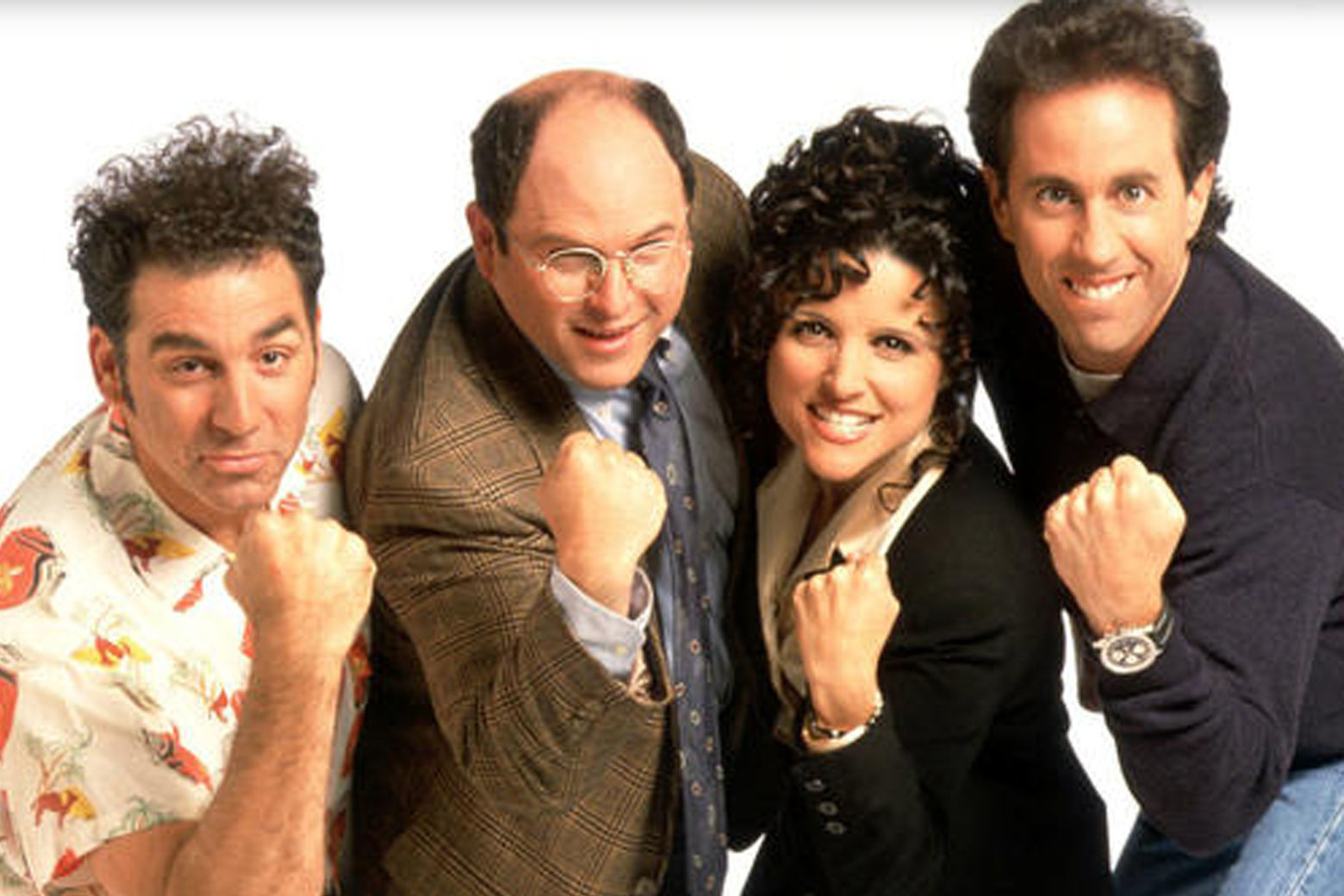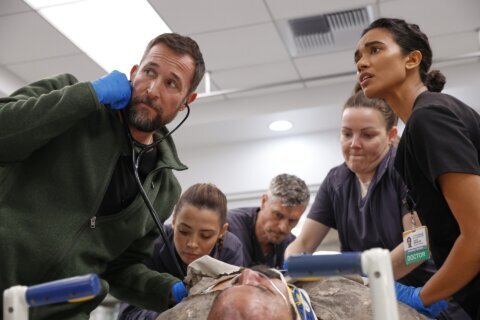
See our WTOP staff picks of their favorite “Seinfeld’ memories at the bottom of the article.
WASHINGTON — Thirty years to the day after the “Seinfeld” pilot “The Seinfeld Chronicles” debuted on NBC on July 5, 1989, the situation comedy remains the Master of its Domain, recently voted by the Writers Guild of America as the best-written sitcom in television history.
Despite critical acclaim, its popularity built slowly over the first few seasons, until it became a ratings juggernaut and pop culture sensation. By 1998, 76.3 million people tuned in to watch the finale as Jerry, George, Elaine and Kramer were convicted by a court of their peers and locked in a jail cell to repeat the same shirt-button discussion that had opened the pilot.
Reaction to the finale was mixed at the time, but in hindsight, it holds up quite well. Not only did its highlight reel provide misty-eyed glimpses of empty apartments set to the world’s first taste of Green Day’s “Time of Your Life,” it also found a creative way to bring back all of its famous characters to return for one last hurrah — testifying against our beloved foursome.
“It was really more of a reunion show than anything else,” Steve Hytner aka Kenny Bania told WTOP over a glass of Roundtine at Mendy’s. “Jerry always said the show treated him so well that he wanted to treat the show well. He wanted it to go out on top, and I feel like it did.”
While other sitcoms often “jump the shark” (i.e. “Happy Days”), play the dating game with their various characters (i.e. “Friends”) or hang around after their star steps away (i.e. “The Office”), “Seinfeld” left at the absolute peak of its popularity. Jerry once said there was something overstated about double digits, so he wanted to leave after nine years, just like The Beatles.
Today, two decades after it left the air, “Seinfeld” remains ubiquitous in our pop culture. Die-hard fans lovingly quote the show on a daily basis around the office to keep the legacy alive (“Hellooo! La la la”). Others unwittingly reference it without even knowing they’re doing so (“No soup for you,” “Yada, yada, yada,” “Bizarro World,” “Hellooo Newman,” “That’s gold!”).
More than catchphrases, it changed our vernacular, altering the way we describe people as high talkers, low talkers, close talkers, two faces, sidlers, mimbos, re-gifters, bad breaker-uppers, those with man hands or jimmy legs, and those who eat their peas one at a time.
The biggest joke, of course, was always on our main characters, who had their own lovably neurotic issues. It’s impossible to pick one as more important than the others. All four protagonists are inextricable: Jerry Seinfeld as himself (“I don’t wanna be a pirate!”), Jason Alexander as George Costanza (“A George divided against itself cannot stand!”), Julia Louis-Dreyfus as Elaine Benes (“Get out!”) and Michael Richards as Cosmo Kramer (“Serenity now!”).
As for writing structure, Larry David and team routinely took chances. Occasionally, this would come in bold narrative choices (a backward episode, an opposite episode). More regularly, they introduced four seemingly unrelated storylines at the start of each episode, only to tie them all together in the end (“Is that a Titleist?” … “And you want to be my latex salesman”).
Of course, it wasn’t all clever fun and games. More often than not, there was a biting subversive edge beneath the scenarios that delved into some daring social commentary.
On the issue of civil rights, LGBT themes were introduced with the line, “We’re not gay! Not that there’s anything wrong with that.” In race relations, the show taught us to “look to the cookie” for black-and-white harmony. And when Jerry dated a Native American, he caught himself on questionable phrases (dinner reservations, ticket scalpers) before she called him out, “Like what?” An Indian Giver?!?” Jerry replied: “I’m sorry, I’m not familiar with that term.”
On the issue of religion, Frank Costanza proclaimed a new holiday with a “Festivus for the rest of us!” There was also Puddy accusing Elaine of stealing his Jesus fish and reprogramming his gospel radio stations. Then of course there was Jerry going into a confessional to complain about Dr. Tim Whatley (Bryan Cranston): “I suspect he converted to Judaism purely for the jokes!” “And that offends you as a Jewish person?” “No, it offends me as a comedian.'”
Most of all, the show examined sex. An early episode found Jerry and Elaine having “sex to save the friendship.” Later, Elaine quizzed mates to see if they were “sponge worthy” for her dwindling birth control supplies. We’ll never forget George explaining his penis shrinkage by screaming, “I was in the pool!” or Jerry’s girlfriend pushing back against claims of breast implants by insisting, “They’re real and they’re spectacular.” Most genius of all was Jerry dating a girlfriend whose mystery name rhymed with a part of the female anatomy: “Dolores!”
The most gutsy episode in this vein was “The Contest,” where the four friends wagered who could go the longest without pleasuring themselves. David’s script won the Emmy for never saying the word “masturbation,” but rather using code words like “Master of Your Domain.” As the Fab Four fall one by one (“I’m out!”), the show made TV and cultural history all at once.
While certain bits are a product of their time (Kramer’s Moviefone: “Why don’t you just tell me the name of the movie you selected?”), the show holds up because of its dissection of daily life. Its over-analysis of the most mundane events gave us a “Sein Language” applicable to any situation, be it waiting at a restaurant, searching a parking garage, or begging for your car rental (“The holding of the reservation is the most important part. Anyone can just take them”).
Which is why the phrase “a show about nothing” was always a misnomer; “Seinfeld” is actually a show about everything. As Jerry strategized with George in the show’s most self-reflexive episode “The Pitch”: “So we go into NBC and tell them it’s a show about nothing. They ask, ‘What’s the show about?’ and we say, ‘Nothing.’ … I think you may have something here!”
“The amazing thing about that show is years later what a classic it is, how iconic it is, and you think, ‘Well, did you know that then?'” Hytner said. “The crazy thing about being on ‘Seinfeld’ was you did know it then. It was like being on ‘I Love Lucy’ and knowing it was ‘I Love Lucy.'”
After years of loving syndication, it doesn’t even feel like “Seinfeld” has left the air at all. If, like me, it’s your favorite show of all time, take this week to introduce someone new to its genius. If you never climbed on board the bandwagon, there’s still time to join the party. Or, if you’re a stubborn contrarian, we fans simply shrug with one response:
That’s a shame.
Hear my chat with Bania and the WTOP staff’s favorite memories in the gallery and video below:








